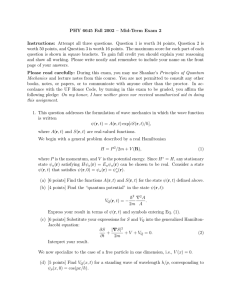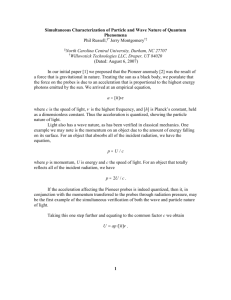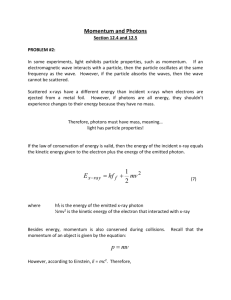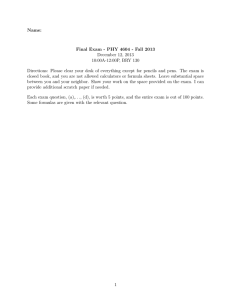Lecture 9 Relevant sections in text: §1.6, 1.7 Momentum wave functions
advertisement
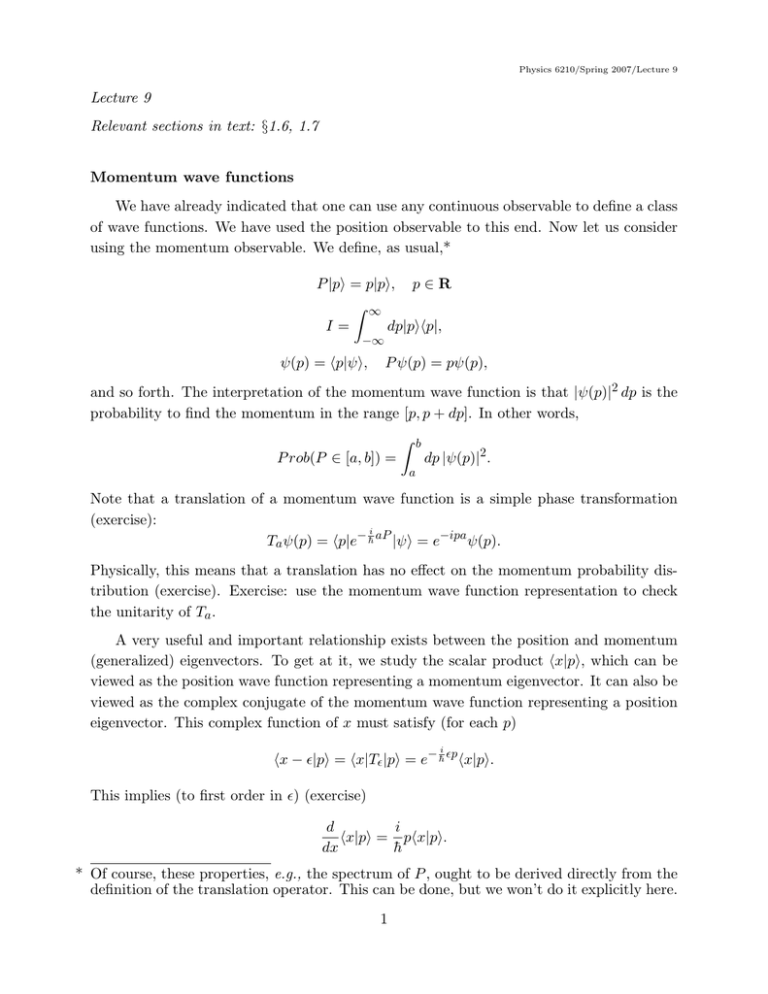
Physics 6210/Spring 2007/Lecture 9 Lecture 9 Relevant sections in text: §1.6, 1.7 Momentum wave functions We have already indicated that one can use any continuous observable to define a class of wave functions. We have used the position observable to this end. Now let us consider using the momentum observable. We define, as usual,* P |pi = p|pi, p ∈ R Z ∞ I= dp|pihp|, −∞ ψ(p) = hp|ψi, P ψ(p) = pψ(p), and so forth. The interpretation of the momentum wave function is that |ψ(p)|2 dp is the probability to find the momentum in the range [p, p + dp]. In other words, Z b P rob(P ∈ [a, b]) = dp |ψ(p)|2 . a Note that a translation of a momentum wave function is a simple phase transformation (exercise): i Ta ψ(p) = hp|e− h̄ aP |ψi = e−ipa ψ(p). Physically, this means that a translation has no effect on the momentum probability distribution (exercise). Exercise: use the momentum wave function representation to check the unitarity of Ta . A very useful and important relationship exists between the position and momentum (generalized) eigenvectors. To get at it, we study the scalar product hx|pi, which can be viewed as the position wave function representing a momentum eigenvector. It can also be viewed as the complex conjugate of the momentum wave function representing a position eigenvector. This complex function of x must satisfy (for each p) i hx − |pi = hx|T |pi = e− h̄ p hx|pi. This implies (to first order in ) (exercise) i d hx|pi = phx|pi. dx h̄ * Of course, these properties, e.g., the spectrum of P , ought to be derived directly from the definition of the translation operator. This can be done, but we won’t do it explicitly here. 1 Physics 6210/Spring 2007/Lecture 9 The solution to this equation is i hx|pi = (const.)e h̄ px . The constant can be determined by the normalization condition: Z ∞ 0 0 δ(p, p ) = hp|p i = dxhp|xihx|p0 i. −∞ Using the Fourier representation of the delta function, Z ∞ 0 1 0 δ(p, p ) = dx eix(p −p) , 2π −∞ we see that (exercise) hx|pi = √ i 1 e h̄ px . 2πh̄ Thus we have recovered a familiar result from wave mechanics: the position space wave function for a particle in a state such that the momentum has (with probability 1) the value p is a (complex) plane wave* with wavelength 2πh̄ p . Because the absolute value of the wave function is unity, the particle has an equal probability of being found anywhere (think: uncertainty relation). Note also that since the energy of a free particle of mass m is P2 H= , 2m this wave function describes a free particle with energy p2 /2m. Because hp|xi = √ i 1 e− h̄ px , 2πh̄ we see that the momentum space probability amplitude for a particle in an idealized state with a definite position is also a plane wave. For an arbitrarily well-localized particle, all momenta are equally likely (uncertainty relation again). With these results in hand we can give an explicit relation between the position and momentum bases: Z ∞ Z ∞ i 1 dp e− h̄ px |pi, |xi = dp|pihp|xi = √ 2πh̄ −∞ −∞ and Z ∞ Z ∞ i 1 |pi = dx|xihx|pi = √ dx e h̄ px |xi. 2πh̄ −∞ −∞ * Of course, plane waves are not normalizable, but we have already discussed this subtlety. 2 Physics 6210/Spring 2007/Lecture 9 If we set ψ(x) = hx|ψi, we get (exercise) ψ̃(p) = hp|ψi, Z ∞ i 1 ψ(x) = √ dp e h̄ px ψ̃(p), 2πh̄ −∞ and Z ∞ i 1 ψ̃(p) = √ dx e− h̄ px ψ(x). 2πh̄ −∞ Thus the position wave functions and momentum wave functions are related by Fourier transforms. Note that (exercise) Z ∞ Z ∞ ∗ hψ|φi = dx ψ (x)φ(x) = dp ψ̃ ∗ (p)φ̃(p). −∞ −∞ In the momentum representation the momentum operator is a “multiplication operator”: P ψ̃(p) = hp|P |ψi = php|ψi = pψ̃(p), while the position operator is a “differentiation operator”: Z ∞ i 1 px − X ψ̃(p) = X √ dx e h̄ ψ(x) 2πh̄ −∞ Z ∞ i 1 =√ dx e− h̄ px xψ(x) 2πh̄ −∞ Z ∞ i h̄ ∂ 1 √ dx e− h̄ px ψ(x) =− i ∂p 2πh̄ −∞ h̄ ∂ ψ̃(p) =− . i ∂p Expectation values Expectation values in the position and momentum representation are easy to compute. Using the notation ψ(x) = hx|ψi, ψ̃(p) = hp|ψi, we have, in particular, the following Z ∞ Z ∞ h̄ d 2 hψ|f (X)|ψi = dxf (x)|ψ(x)| = )ψ̃(p), dp ψ̃ ∗ (p)f (− i dp −∞ −∞ and Z ∞ hψ|f (P )|ψi = dpf (p)|ψ̃(p)|2 = −∞ Z ∞ −∞ 3 dx ψ ∗ (x)f ( h̄ d )ψ(x), i dx Physics 6210/Spring 2007/Lecture 9 You should prove these as a very good exercise. Particle in 3 dimensions The generalization to a particle in 3 dimensions is done by, essentially, tripling our previous constructions. Here we briefly describe this generalization. Afterward, I will show you how to view in general this way of adding “degrees of freedom” to a quantum mechanical model. In 3-d, we now have position vectors X with components X i = (X, Y, Z), and momentum vectors P with components Pi = (Px , Py , Pz ). Each pair (X i , Pi ) is represented by self-adjoint operators exactly as before. We demand that they have the following canonical commutation relations: [X i , X j ] = [Pi , Pj ] = 0, [X i , Pj ] = ih̄δji I. We have position (generalized) eigenvectors |xi and momentum (generalized) eigenvectors |pi, X i |xi = xi |xi, Pi |pi = pi |pi. These form a (generalized) basis: Z Z 3 d x |xihx| = I = d3 p |pihp|. Here it is understood that the integrals run over all of position/momentum space. The self-adjoint momentum operators generate unitary transformations corresponding to 3-d translations: i Ta = e− h̄ a·P , Ta |xi = |x + ai. The canonical commutation relations reflect the fact that translations are commutative operations: i Ta Tb = Tb Ta = e− h̄ (a+b)·P = Ta+b . Note that the commutation relations allow us to choose a basis of simultaneous (generalized) eigenvectors of the position or momentum. The relation between the two bases is i 1 e h̄ p·x . hx|pi = (2πh̄)3/2 The position wave functions and momentum wave functions are defined as usual by taking the components of a state vector along the corresponding basis: ψ(x) = hx|ψi, ψ̃(p) = hp|ψi. 4 Physics 6210/Spring 2007/Lecture 9 We then have X i ψ(x) = xi ψ(x), and X i ψ̃(p) = − Pi ψ(x) = h̄ ∂ ψ̃(p), i ∂pi h̄ ∂ ψ(x), i ∂xi Pi ψ̃(p) = pi ψ̃(p), The probability distributions for finding position/momentum in a volume V /Ṽ are Z Z 3 2 d x |ψ(x)| , P rob(P ∈ Ṽ ) = d3 p |ψ̃(p)|2 . P rob(X ∈ V ) = V Ṽ 5

